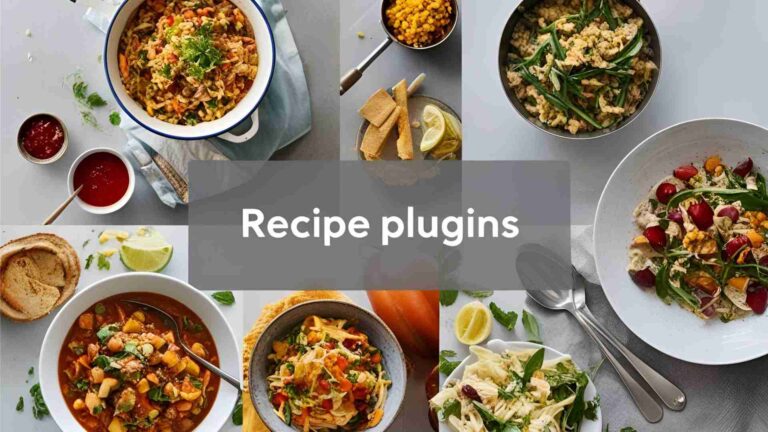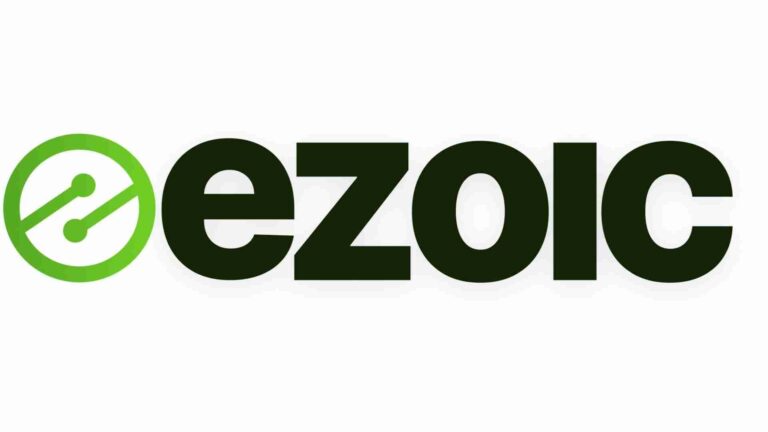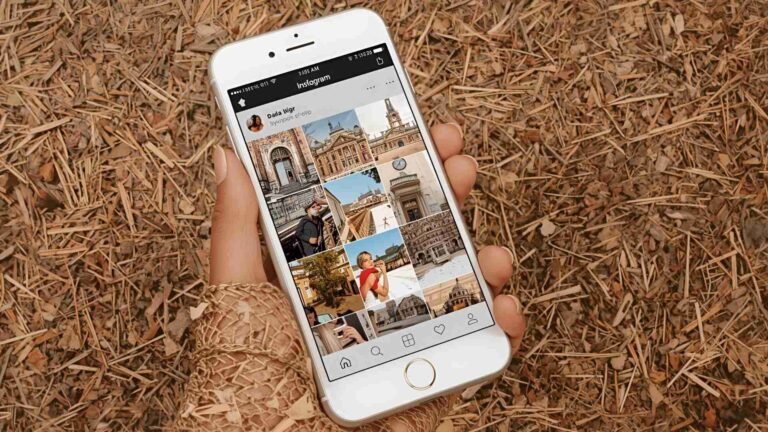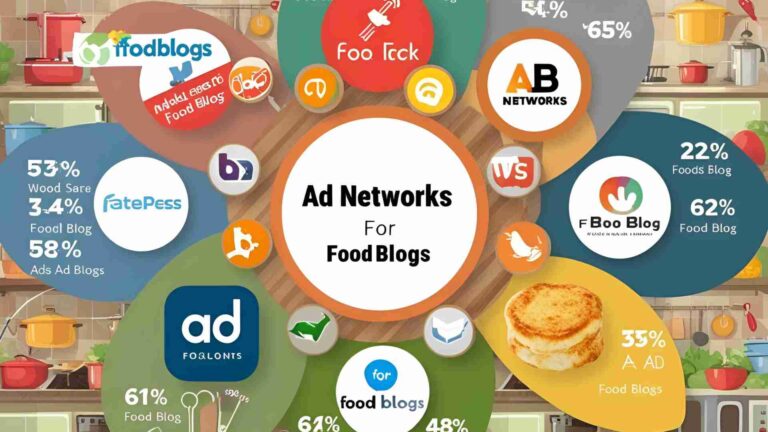The ‘MAGIC’ Framework for Negotiating with Brands
Master brand negotiations with the MAGIC framework. Learn to map goals, assess brand needs, gather insights, and collaborate effectively.
Negotiating with brands is a critical skill for content creators, influencers, and small business owners looking to monetize their platforms through sponsored partnerships. Whether you’re a food blogger, a lifestyle influencer, or a niche content creator, securing mutually beneficial brand deals can significantly boost your revenue and visibility. However, the negotiation process can feel intimidating, especially when contracts, expectations, and competing priorities come into play. Enter the MAGIC framework, a structured, collaboration-focused approach designed to streamline negotiations and help you achieve successful outcomes. This comprehensive guide explores the MAGIC framework, breaks down its components, and provides actionable strategies to help you negotiate with confidence and clarity.
Why Negotiate with Brands?
Brand partnerships are a cornerstone of monetization for many online creators. From sponsored blog posts to Instagram campaigns, these collaborations allow creators to showcase products or services to their audience while earning compensation. However, the process involves more than just agreeing to a deal—it requires aligning your goals with the brand’s objectives, ensuring fair terms, and protecting your creative control. Negotiations are the bridge that connects both parties, helping to outline expectations, deliverables, and compensation in a contract.
The stakes are high: a well-negotiated deal can enhance your reputation, grow your audience, and provide financial rewards, while a poorly negotiated one might undervalue your work or compromise your creative vision. The MAGIC framework, developed by legal expert Danielle Liss from Businessese, offers a step-by-step approach to make negotiations less daunting and more collaborative. By focusing on preparation, empathy, and strategic communication, this framework empowers creators to advocate for themselves while building strong, lasting relationships with brands.
The MAGIC Framework: A Step-by-Step Breakdown
The MAGIC framework stands for Map, Assess, Gather, Insights, and Collaborate. Each step builds on the previous one, creating a cohesive strategy for navigating brand negotiations. Below, we dive into each component, offering practical tips and examples to guide you through the process.
M: Map What You Want
The first step in any negotiation is to define your goals and priorities. Mapping what you want ensures you enter discussions with clarity and confidence, avoiding the trap of accepting terms that don’t align with your vision.
Key Considerations:
- Compensation: Determine your ideal rate based on the value you bring to the partnership. Consider factors like audience size, engagement rate, and the effort required for deliverables (e.g., a blog post, video, or social media campaign).
- Scope of Work: Outline the specific deliverables you’re willing to provide, such as the number of posts, types of content (e.g., photos, videos, or stories), and editing rounds.
- Creative Control: Decide how much control you’re comfortable giving the brand over your content. For example, are you okay with them dictating specific language or requiring approval before posting?
- Non-Negotiables: Identify your deal-breakers, such as exclusivity clauses that limit your ability to work with other brands or terms that undervalue your work.
Example:
A food blogger negotiating a sponsored post for a kitchen appliance brand might map their goals as follows:
- Compensation: $1,500 for a blog post and two Instagram posts.
- Scope: One blog post with a recipe, two Instagram posts, and one Instagram Story.
- Creative Control: Retain the ability to write in their authentic voice, with the brand providing general guidelines rather than specific wording.
- Non-Negotiables: No exclusivity clause that prevents working with competing brands for more than 30 days.
By creating a clear list of “must-haves” and “nice-to-haves,” you can approach negotiations with a plan that protects your brand and ensures fair compensation.
A: Assess What the Other Side Wants
Understanding the brand’s perspective is crucial for crafting a proposal that meets their needs while advancing your goals. Brands partner with creators to solve specific problems, such as increasing product visibility, driving sales, or reaching a new audience. By assessing their priorities, you can position yourself as a valuable partner who offers tailored solutions.
How to Assess Brand Needs:
- Research the Brand: Review their website, social media, and recent campaigns to understand their target audience, marketing goals, and brand voice.
- Ask Questions: During initial discussions, inquire about their objectives. For example, are they launching a new product, aiming for email signups, or seeking brand awareness?
- Analyze Past Collaborations: Look at the brand’s previous partnerships to identify patterns in their expectations, such as preferred content formats or campaign metrics.
Example:
If a skincare brand is launching a new moisturizer, they might want to reach a younger demographic through Instagram Reels. By understanding this goal, a beauty influencer can propose a series of short, engaging videos that highlight the product’s benefits, aligning their pitch with the brand’s marketing strategy.
G & I: Gather Insights
The “Gather” and “Insights” steps involve researching and synthesizing information to inform your negotiation strategy. This step combines your understanding of your own goals (from the “Map” step) with the brand’s objectives (from the “Assess” step) to create a tailored plan.
Research Areas:
- Industry Standards: Investigate typical rates and deliverables for creators in your niche. For example, a 2023 Influencer Marketing Hub report found that Instagram influencers with 10,000–50,000 followers typically charge $100–$500 per post.
- Brand History: Review the brand’s past collaborations to understand their budget, preferred contract terms, and negotiation style.
- Competitor Analysis: Look at what similar creators are offering in their partnerships to ensure your proposal is competitive.
Tools for Gathering Insights:
- Social Media Analytics: Use platforms like Instagram Insights or YouTube Analytics to quantify your audience’s demographics and engagement.
- Industry Reports: Leverage resources like Influencer Marketing Hub or CreatorIQ for data on influencer rates and trends.
- Networking: Connect with other creators in your niche to share insights on brand partnerships and negotiation tactics.
Chart: Negotiation Research Workflow
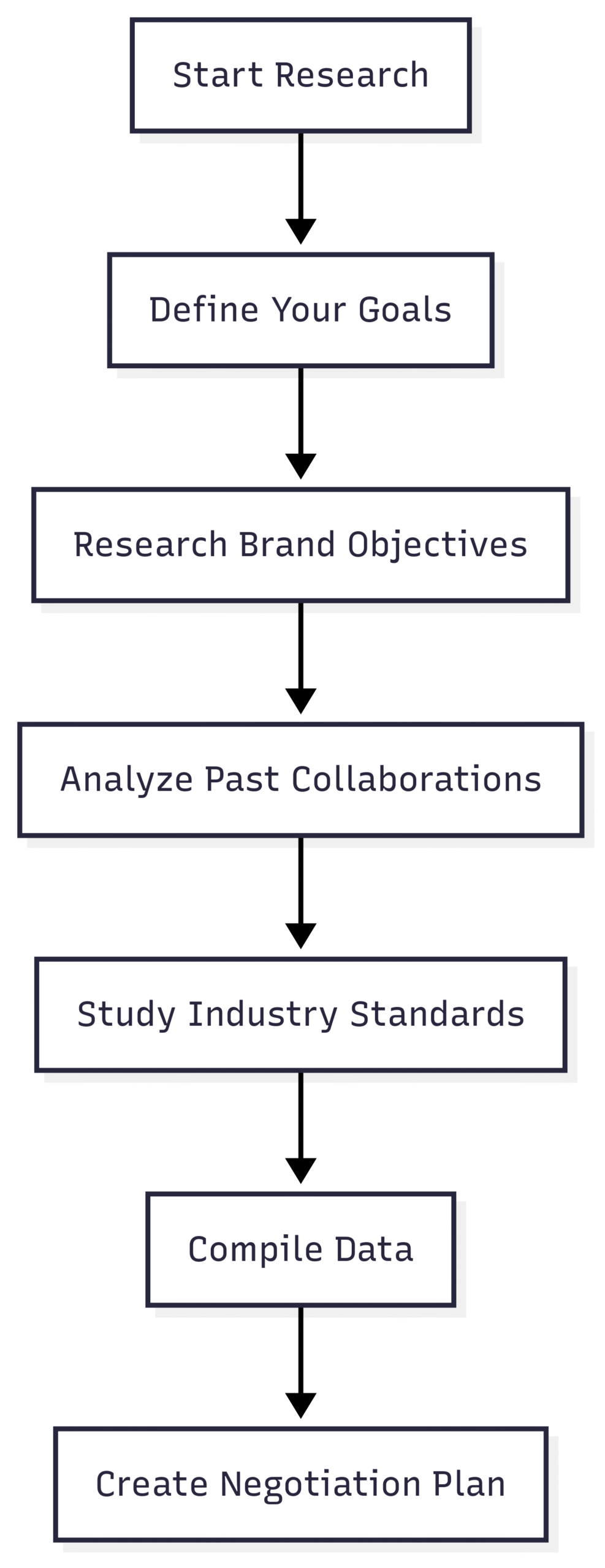
This chart illustrates the flow of gathering insights, from defining your goals to creating a negotiation plan based on research.
C: Collaborate
The final step is to approach negotiations as a collaborative process, not a confrontation. By focusing on mutual benefits, you can build trust with the brand and craft an agreement that satisfies both parties.
Strategies for Collaboration:
- Open Communication: Be transparent about your needs and willing to listen to the brand’s concerns. For example, if a brand requests lifetime ownership of your content, propose a licensing agreement instead, specifying usage rights for a set period.
- Creative Problem-Solving: If a term doesn’t work for you, suggest alternatives. For instance, if a brand’s budget is lower than your rate, offer a reduced scope (e.g., fewer posts) rather than lowering your price.
- Build Rapport: Establish a positive relationship with brand representatives by being professional, responsive, and empathetic.
Example:
During negotiations with a beverage brand, a creator might discover the brand wants exclusive rights to their content for six months. Instead of rejecting the term outright, the creator could propose a three-month exclusivity period with a higher fee to reflect the added value.
Key Elements of Negotiation
Beyond the MAGIC framework, successful negotiations hinge on understanding key elements that drive the process. These principles, drawn from the Program on Negotiation at Harvard Law School, provide a foundation for navigating complex discussions.
| Element | Description |
|---|---|
| Interests | Identify the underlying needs, wants, and motivations of both parties. |
| Legitimacy | Ensure the negotiation process is fair, transparent, and based on objective standards. |
| Relationships | Build trust and rapport to foster long-term partnerships. |
| BATNA | Know your Best Alternative to a Negotiated Agreement—your fallback plan if the deal fails. |
| Options | Explore creative solutions to meet both parties’ needs. |
| Commitment | Clarify what each party is willing to commit to in the agreement. |
| Communication | Use clear, empathetic communication to align expectations and resolve conflicts. |
BATNA in Action
Your BATNA is your backup plan if negotiations don’t result in a favorable agreement. For example, if a brand offers $500 for a campaign but your minimum rate is $1,000, your BATNA might be to pursue another brand partnership or focus on organic content that drives affiliate revenue. Knowing your BATNA gives you confidence to walk away from a deal that doesn’t meet your standards.
Common Contract Clauses in Brand Partnerships
Contracts are the backbone of brand partnerships, outlining the terms of the collaboration. Below are common clauses you’ll encounter and tips for negotiating them:
| Clause | Description | Negotiation Tip |
|---|---|---|
| Scope of Work | Details deliverables, such as the number of posts or content format. | Be specific about deliverables to avoid scope creep (e.g., “one blog post, 500 words”). |
| Payment Terms | Specifies compensation amount, schedule, and method (e.g., PayPal, bank transfer). | Request a deposit or partial payment upfront to secure commitment. |
| Ownership of Content | Defines who owns the content after creation (creator, brand, or shared). | Negotiate for licensing rights rather than full ownership to retain control. |
| Exclusivity | Restricts you from working with competing brands for a set period. | Limit exclusivity to a short duration (e.g., 30 days) or charge a premium for longer terms. |
| Termination | Outlines conditions for ending the partnership early. | Ensure termination clauses are mutual and fair to both parties. |
| Drafts | Specifies whether the brand requires draft reviews before publishing. | Set a limit on revision rounds (e.g., two rounds) to manage workload. |
| Likeness Release | Grants the brand permission to use your image or likeness in their marketing. | Clarify where and how your likeness will be used to avoid unexpected exposure. |
| Reshoots | Requires additional content creation if the initial deliverables don’t meet standards. | Negotiate additional compensation for reshoots to account for extra time and effort. |
Tips for Successful Brand Negotiations
To maximize your success, incorporate these practical tips into your negotiation strategy:
- Start with a Draft Contract: Prepare a sample contract outlining your terms to set clear expectations from the outset. This demonstrates professionalism and streamlines discussions.
- Break Down Complex Agreements: Divide negotiations into smaller components (e.g., payment, deliverables, exclusivity) to make the process more manageable.
- Know Your “Why”: Understand your motivations for the partnership, whether it’s financial, exposure, or aligning with a brand you admire. This clarity helps you prioritize key terms.
- Prioritize Key Objectives: Focus on the most critical aspects of the deal, such as fair compensation or creative control, and be flexible on less important points.
- Ask Questions: Clarify the brand’s goals and constraints to find common ground. For example, ask, “What metrics are you aiming to achieve with this campaign?”
- Come Prepared with Research: Use data from your analytics and industry benchmarks to justify your rates and deliverables.
- Know When to Walk Away: If a deal doesn’t align with your goals or undervalues your work, be prepared to decline politely. A strong BATNA empowers you to make this decision confidently.
Real-World Example: Applying the MAGIC Framework
Imagine you’re a travel influencer negotiating a partnership with a luggage brand. Here’s how the MAGIC framework might play out:
- Map What You Want: You aim for $2,000 for a YouTube video and two Instagram posts, retaining full ownership of your content and limiting exclusivity to 60 days.
- Assess What the Brand Wants: The brand is launching a new suitcase and wants to target adventure travelers through engaging video content.
- Gather Insights: Research shows similar influencers charge $1,500–$2,500 for video content. The brand’s past campaigns focused on Instagram Reels with high engagement.
- Collaborate: You propose a YouTube video showcasing the suitcase in action, plus two Instagram posts. When the brand requests full content ownership, you counter with a one-year licensing agreement for an additional $500.
This approach results in a deal that meets the brand’s marketing goals while securing fair compensation and creative control for you.
Pricing Guidelines for Brand Partnerships
While pricing varies by niche, audience size, and deliverables, here are general benchmarks based on industry data:
| Platform | Audience Size | Typical Rate per Post |
|---|---|---|
| 10,000–50,000 | $100–$500 | |
| 50,000–100,000 | $500–$1,000 | |
| YouTube | 10,000–50,000 | $500–$2,000 |
| Blog Post | Any size | $250–$1,500 |
Note: Rates depend on engagement, niche, and content complexity. Always factor in your time, expertise, and production costs when setting prices.
Conclusion
The MAGIC framework—Map, Assess, Gather, Insights, Collaborate—offers a powerful, structured approach to negotiating with brands. By clearly defining your goals, understanding the brand’s needs, researching thoroughly, and fostering collaboration, you can secure partnerships that are both financially rewarding and creatively fulfilling. Whether you’re a seasoned influencer or just starting out, mastering this framework will help you navigate negotiations with confidence, build strong relationships, and grow your brand’s value. Start applying the MAGIC framework today to transform your brand partnerships into win-win collaborations.
Please share these The ‘MAGIC’ Framework for Negotiating with Brands with your friends and do a comment below about your feedback.
We will meet you on next article.
Until you can read, Sunshine Strawberry Banana Shake Smoothie


